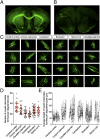Neurite outgrowth inhibitor Nogo-A establishes spatial segregation and extent of oligodendrocyte myelination
- PMID: 22160722
- PMCID: PMC3268264
- DOI: 10.1073/pnas.1113540109
Neurite outgrowth inhibitor Nogo-A establishes spatial segregation and extent of oligodendrocyte myelination
Abstract
A requisite component of nervous system development is the achievement of cellular recognition and spatial segregation through competition-based refinement mechanisms. Competition for available axon space by myelinating oligodendrocytes ensures that all relevant CNS axons are myelinated properly. To ascertain the nature of this competition, we generated a transgenic mouse with sparsely labeled oligodendrocytes and establish that individual oligodendrocytes occupying similar axon tracts can greatly vary the number and lengths of their myelin internodes. Here we show that intercellular interactions between competing oligodendroglia influence the number and length of myelin internodes, referred to as myelinogenic potential, and identify the amino-terminal region of Nogo-A, expressed by oligodendroglia, as necessary and sufficient to inhibit this process. Exuberant and expansive myelination/remyelination is detected in the absence of Nogo during development and after demyelination, suggesting that spatial segregation and myelin extent is limited by microenvironmental inhibition. We demonstrate a unique physiological role for Nogo-A in the precise myelination of the developing CNS. Maximizing the myelinogenic potential of oligodendrocytes may offer an effective strategy for repair in future therapies for demyelination.
Conflict of interest statement
The authors declare no conflict of interest.
Figures





Comment in
-
A Nogo signal coordinates the perfect match between myelin and axons.Proc Natl Acad Sci U S A. 2012 Jan 24;109(4):1003-4. doi: 10.1073/pnas.1120301109. Epub 2012 Jan 17. Proc Natl Acad Sci U S A. 2012. PMID: 22308525 Free PMC article. No abstract available.
References
Publication types
MeSH terms
Substances
Grants and funding
LinkOut - more resources
Full Text Sources
Other Literature Sources
Molecular Biology Databases

